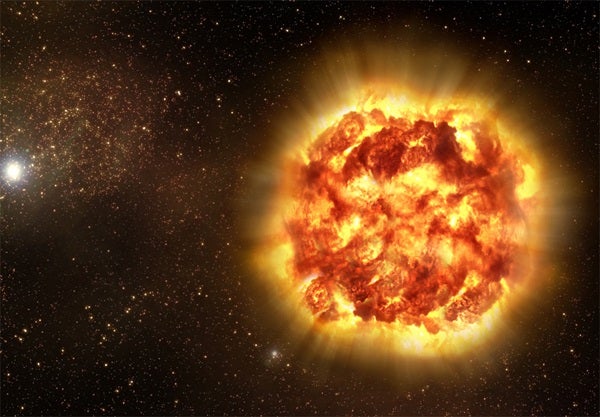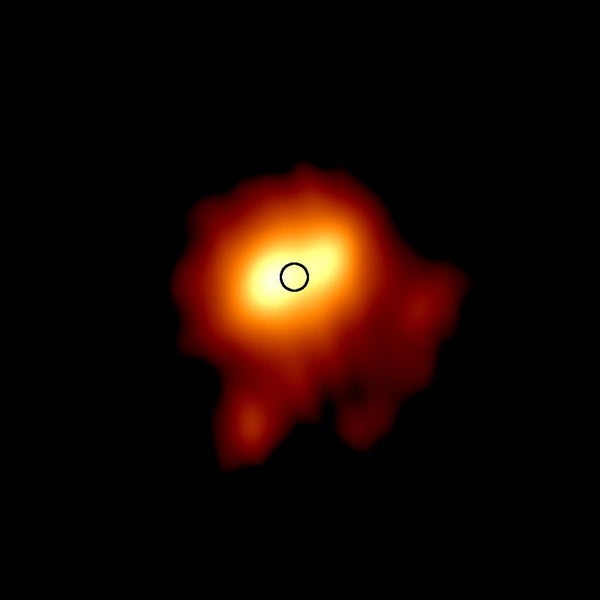
An artist’s impression of how a type Ia supernovae may look as revealed by spectro-polarimetric observations. The outer regions of the blast cloud is asymmetric, with different materials found in ‘clumps’, while the inner regions are smooth. Credit: ESO.
It’s easy to forget that stars, just like us, have lifetimes. They’re born, they live, and eventually, they die. And for some stars, their death is dramatic, producing an explosion so powerful it can briefly outshine an entire galaxy. These celestial fireworks are known as supernovae, and they serve as the universe’s most striking reminders of the cycle of stellar life.
But not all supernovae are created equal. Differences in progenitor stars and the mechanisms of their explosions produce different types of supernovae, with each leaving behind a unique spectral fingerprint. And understanding these different types of supernovae is not just a matter of cosmic classification; it provides crucial insights into the life and death of stars.
Type I supernovae: No hydrogen
Type I supernovae are primarily characterized by a lack of hydrogen present in their spectra. But the stars that create the various flavors of type I supernovae aren’t all the same.
Type Ia supernovae
Type Ia supernovae arise in binary systems, when a carbon-oxygen white dwarf accumulates additional matter from a nearby companion star. Once the white dwarf reaches a critical mass – around 1.4 times the mass of the Sun – it catastrophically implodes. These supernovae are famous for their role as cosmic distance markers because they all peak with about the same brightness.
The spectra of a type Ia supernova shows little or no hydrogen and an excess of carbon, as well as silicon, calcium, and iron.
At just 23 million light-years away, the explosion of supernova SN 2011fen, which was seen in the Pinwheel Galaxy in 2011, is one of the closest and best-observed Type Ia supernovae to date.
Type Ib supernovae:
Unlike type Ia supernovae, Type Ib supernovae are the result of stars at least 25 times the mass of the Sun going supernova.
The spectra of type Ib supernovae show a lack of hydrogen due to the massive progenitor stars shedding their outer layers late in their lives, often due to particularly strong stellar winds or interactions with a binary companion. Type Ib supernovae also lack a silicon absorption line that is present in the spectra of type Ia supernovae.
Type Ic Supernovae:
Like type Ib, type Ic supernovae are thought to form from the collapse of particularly massive stars that have previously lost their outer layers. That’s why both type Ib and type Ic supernovae are commonly referred to as stripped core-collapse supernovae.
The spectra of type Ic supernovae not only lacks hydrogen, but it also lacks helium. This is because, prior to exploding, type Ic supernovae are thought to lose more of their initial envelope than type Ib supernova. Type Ic supernovae also lack the silicon line seen in type Ia spectra.
Type II supernovae: Shows hydrogen
Originating from massive stars (at least eight times the mass of our Sun) that rapidly collapse when they’ve exhausted their nuclear fuel, type II supernovae differ from type I because they exhibit strong hydrogen lines.
The progenitor stars of type II supernovae are massive enough to fuse elements up to iron. But once iron is reached, fusion ceases and the star gravitationally implodes before violently exploding outward. This leaves behind either a neutron star or a black hole.
Subcategories of type II supernovae are based on how their brightness evolves after they explode.
Type II-PThese supernovae are marked by an initial “plateau” in their light curve due to a prolonged and steady release of energy followed by a normal decline.
Type II-LDiffering from II-P, the luminosity of these supernovae linearly declines following the explosion.
Type III supernovae: Electron-capture
Emerging from theories dating back to 1980, electron-capture supernovae, sometimes classified as Type III supernovae, are reserved for stars of 8 to 10 solar masses. These unique stars teeter between evolving into white dwarfs and undergoing core-collapse to become neutron stars or black holes.
The mechanism leading to a Type III supernova is called electron capture. In the dense core of these star, electrons are captured by magnesium and neon atoms. This rapidly reduces the number of free electrons, which contribute to the outward pressure resisting the star’s gravitational collapse. As a result, the star implodes, leading to a supernova.
This theory gained more traction when a 2018 discovery of supernova in the galaxy NGC 2146 was shown to fit the electron-capture profile in 2021.
Betelgeuse and other stars with explosive futures

In this new image of the outer atmosphere of the red supergiant Betelgeuse, the colors represent brightness ranging from faintest (red) to brightest (white). The black circle represents the visual size of the star. Credit: Royal Astronomical Society/e-MERLIN
Looming over the constellation Orion, Betelgeuse, a red supergiant, is famously nearing the end of its life. While its exact time of death remains uncertain, astronomers estimate the roughly 15-solar-mass behemoth will explode as a supernova within the next 10,000 to 100,000 years. Based on its current characteristics and massive nature, Betelgeuse is expected to explode as a type II supernova, leaving behind either a neutron star or a black hole in its place.
When Betelgeuse finally does explode, it will be a breathtaking celestial spectacle, potentially shining as bright as the Full Moon and remaining visible for several weeks or months.
Eta Carinae, a truly supermassive star, has a tumultuous past. And its dramatic outbursts in the 19th century, which created the stunning Homunculus Nebula, hints at its volatile nature. Despite currently weighing in at about 100 solar masses, astronomers expect accelerated mass loss to ultimately lead to Eta Carinae exploding as a type II supernova sometime in the next few million years.
Antares, the heart of the constellation Scorpius, is a radiant red supergiant that likewise is nearing the end of its life cycle. Astronomers predict that within the next few million years, Antares will meet a dramatic end as a type II supernova, reshaping the celestial landscape of the Scorpion.
By understanding supernovae, we not only learn about the complicated and catastrophic deaths of stars, but also how such events can help seed the cosmos with the heavy elements required to create both our world and ourselves.
So, although astronomers can never really predict when and where the next supernova will occur, you can be certain that if it’s bright enough to see, they’ll do everything they can to understand its true nature.





